Social media will put you in the financial graveyard
Pete Zimmerman | 11/10/2022
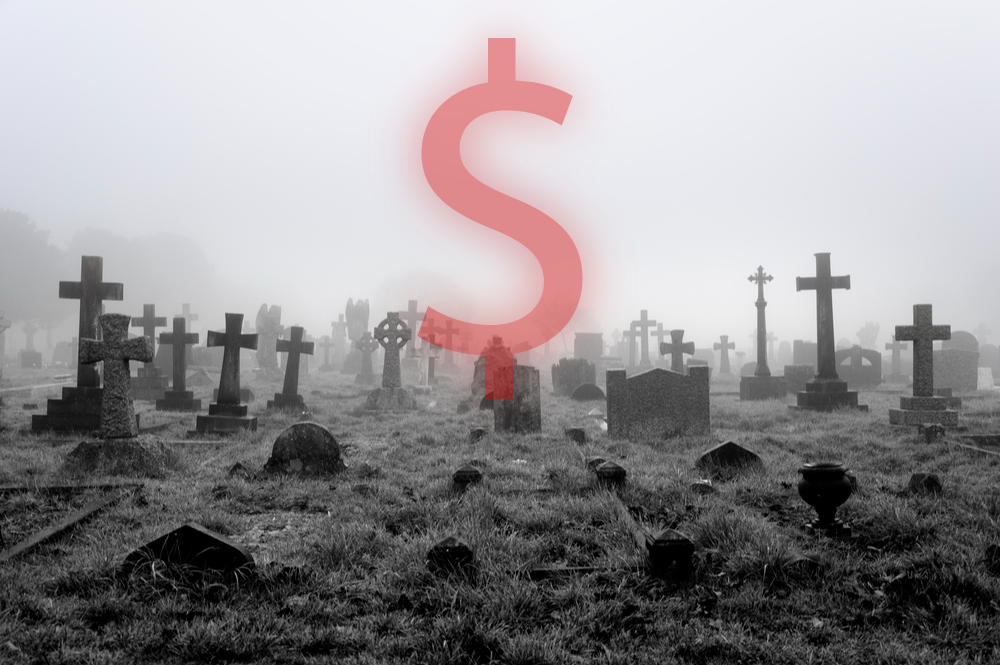
This post at a glance
( TL ; DR )
If you're in a hurry, you can also hit GO TO VIDEO below
Read time: 10 minutes
Summary: Social media pretends to be noble. You've heard them sell it before: keeping people connected, letting you interact with the world, blah blah blah. But under this public mask, social media is a BUSINESS with it's own motives, and using it can have negative side effects. If you don't understand who you're dealing with, what their goals are, and how they really operate, you're being deceived (and used). And it could be costing you much more than time wasted scrolling. It can also be destructive to your bank account.
You have hidden mental history that you probably don't even know about
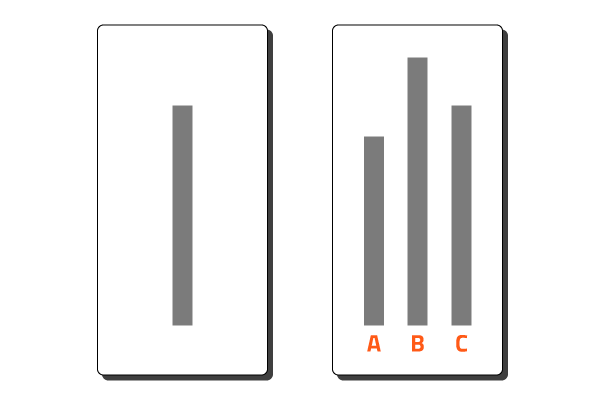
Take a look at the simple cards above. Can you tell which line from the second card matches the single line on the first card? Is it A, B, or C?
It's Line B.
Do you believe me?
Would you believe me if I were sitting there in the room with you, pointing at Line B? What if there were 20 other people there with the two of us, and every one of them nodded and agreed with me?
100 people? Or 1,000? Wouldn't you start to wonder whether you were missing something?
Maybe it's a nasty trick. Or an optical illusion and you're the only one who doesn't get it. Are the others whispering behind your back that you're some kind of weirdo? How could everyone else be wrong?
Social pressure is POWERFUL.
You may not always feel it, but it's always right there, under the surface every time you interact with other people, every day. You're an independent person, but your brain is also WIRED to help you maneuver within the herd.
But this old caveman wiring can also lead to surprising results and can have unpredictable effects on your life.
In the 1950's, a psychologist named Soloman Asch started a set of experiments using the two cards just like above. During the experiment, Asch asked his students a simple question: to identify which line on the second card matched the first. Not surprisingly, they got it right almost every time (it's not B, as you guessed by now).
But then Asch added a twist.
He introduced several new people, asked these people to answer the question first, and let the participant hear each of those responses before it was their turn to answer. The participants didn't know it, but these new people were actors and were part of the experiment. With Aschs' instruction, the fake participants unanimously gave the wrong answer. Asch figured that the participant would stick to their guns and give the answer they knew was right.
To his astonishment, most of them ... didn't.
Instead, three out of four of people conformed with the fake participants and gave the obviously wrong answer at least once, and participants gave incorrect (but popular) answers in 32% of cases.
Participants ditched their own opinions, even though they knew they were right.
And not because someone was holding a gun to their head, or because someone convinced them with a great argument, or pointed out errors in their judgement. But just because it's what everyone else was doing. All that it took was witnessing what others were doing, and some subconscious need to fit in with the group.
This is a big deal, and it shines a light into the human psyche (yeah, that includes you too) when you're confronted with the opinions and actions of other people. Even those which go against your own instincts, ethics, or convictions.
Ok, so what does this mean?
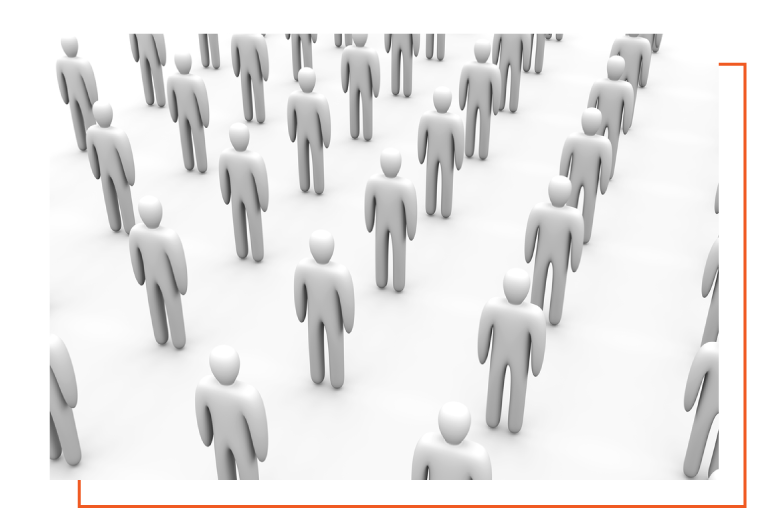
It means that unless you're a hermit or living off grid (how are you reading this?), you're trapped in a system that rewards conformity and fitting in. And at the same time, you have to live with the consequences of those choices, even if they're suicidal to your finances, and you were duped into them by your damn caveman wiring.
How about an example to prove it?
Say you go out for a night on the town with your friends, and end up spending $100 more than you meant to. The “payoff” for this is vague, and the choices you make throughout the night are influenced by a number of things outside of your control. But the costs for you — individually — are REAL. They affect you directly, and you alone. Your friends won't be paying that shortfall in your rent money just because they had a hand in your shenanigans. Ask them and see what they say.
And none of this is letting up.
Since the '50s, would you say that social pressure has dropped? Is there less of it?
Social pressure is increasing rapidly
Absolutely not. Communication is done at lightning speed today. People used to mail letters and talk on phones that were attached to their house. Now, smart phones, networking, and messaging via apps and the web are everywhere.
But what's the #1 reason that social pressure has skyrocketed? SOCIAL MEDIA: a psychological monster DESIGNED around social awareness.
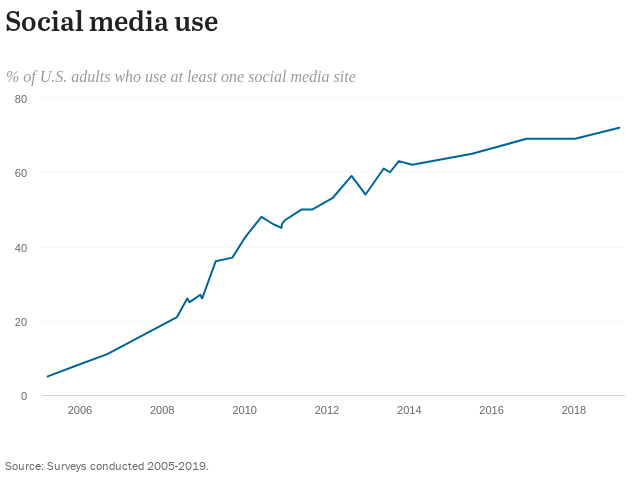
Social media has a lot of societal baggage. That's right in everyone's face, but there's not much you can do.
We're going to focus on something you can actually control, once you get wise to what's happening. This is like a stealth, silent, serial killer, hiding in the bushes waiting to ambush you: social media's impact on your money.
First off, let's take a look at who we're dealing with.
Social media knows you. But do you know them?
For almost a decade, Facebook's home page slogan was It's free and always will be. It's different now, but was it ever true? There's a more honest answer buried on one of Facebook's own help pages:
“No, we don't charge you to use Facebook. Instead, we charge advertisers to show ads on the Facebook family of apps and technologies. This helps us make Facebook available to everyone without charging people for access to it.”
Hmm, almost seems reasonable, doesn't it. That's how radio works too, right? You just have to tolerate the commercials to get the free content.
Well no, not really.
In 2020, advertisers spent over $40 billion dollars advertising on social media. Spending for 2022 is expected to be $56 billion. Those are gargantuan sums of money, and it turns out those advertisers are getting something for their money. Something that other mass media can't give them: you. Specifically, your personal information and the means to target you.
Radio stations don't know that you're in a relationship when they broadcast to your car during your commute. They don't know who you work for. And they don't know that you hit Like on a friend's post about her new Coach purse. Social media DOES know this. Facebook has almost 100 data points on you that they use to categorize and package you up and offer you to their advertisers. This isn't an exagerration. It's exactly how it works.
Facebook and Instagram are the store. Advertisers are the shoppers. And what are you? You're what's being bought. You're the product.
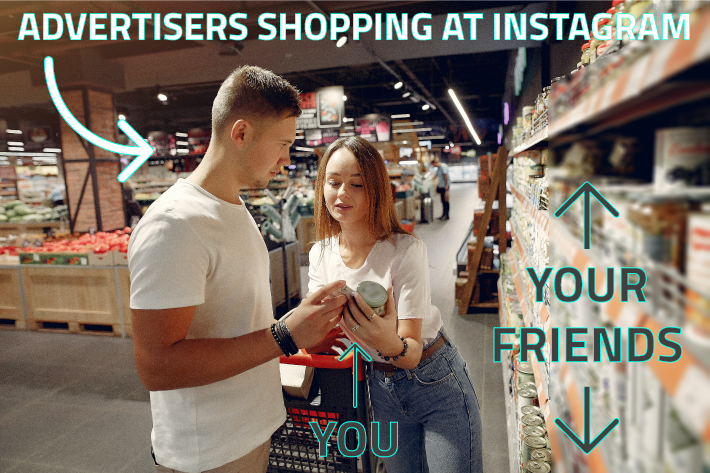
What's that mean for social media? Well, for Facebook and Instagram (same company), it means about $115 billion in advertising revenue.
What's it mean for advertisers? It means an audience who is more primed to buy because they know you. Good deal for them.
And what's it mean for you? It means that you are going to be tempted by the very thing that you're susceptible to, since advertisers have exactly what they need to target you. Maybe you just ended a relationship, updated Facebook, and suddenly you're seeing ads for online dating services. That's not a coincidence.
Rest assured, out the the three groups involved here, you won't be the one making money in this deal. Because you are the one being sold, and sold to.
So again, is it really free?
A recent study showed that individuals spent an average of $140 over the last six months on “sponsored content” (or we could call it what it is- ads). That means Instagram could charge you a $10 per month fee to use it, ditch the ads, and on average, that would cost you LESS than it's costing you now.
And this doesn't even count the major financial side effects of social media:
Impuse spending
FOMO
Influencer marketing
Ads
We'll get into those. But first let's pull back the social media mask even further, and learn more about who and what we're really dealing with.
Social media isn't real. It's just as fake as any commercial that you see on TV or hear on the radio.
Part of the draw of social media is that it seems authentic. It's real people, doing real things and sharing them with the world. Except in reality, social media is a total poser. It isn't designed or even intended to show an authentic picture of people's lives. And yes, that includes people that you know.
A 2011 study proved that with social media, “people may think they're more alone in their emotional difficulties than they really are”. Because everyone on social media seems to be doing great (except you). Would it even surprise you that it's all an act?

Your social media connection blasts the internet with photos of the amazing night out they're having, but they aren't showing off pictures of themselves comatose on the bathroom floor the next morning, nursing a 5-alarm headache and regretting those last two shots of tequila. And then driving to work at Payless Shoes on Monday morning, a few hundred dollars poorer.
Of course they're going to put their best face forward, trying to make a good impression. But it's not reality.
Does that seem harsh? Too bad, it's true. And it's important to understand when you're attempting to understand social media for what it is.
People only put their best out there for the world to see.
Yet everyday, you are compelled to feel bad about your “mundane” life because of the carefully curated content that others put on social media. Newsflash: everyone's lives are mundane. Don't let them make you think otherwise, and don't beat yourself up trying to keep up with the Joneses when they aren't even keeping up with themselves.
So the posts, for all intents and purposes, can be fake. And on the other side, even followers can be fake.
Facebook has about 137 million fake accounts, or about 16% of all accounts. That goes along with at least 95 million on Instagram. Allegedly, the British royal family has almost 2 million fake followers of their own. Social media influencers and wannabe influencers often buy these fake followers to try and gain credibility. So ... do popularity and followers on social media really mean what everyone seems to think they mean?
None of this is a problem in and of itself — make-believe is part life. There's nothing wrong with reading a novel or watching a series on Netflix, and those aren't real. But everyone KNOWS they're made-up. They know it right away and don't alter their lives or make any decisions because of it. Netflix does't affect your perception of yourself and your place in society. And it definitely doesn't murder your finances in the process. Social media does.
And here are the four sneaky ways that it seeps into your life, using tricks that you may barely perceive, but always pay for. Learn how you're being manipulated and used, so you can fight back.
1: Being stuck on auto-pilot
2: FOMO
3: Influencers selling to you
4: High-tech, effective ads
1: Being stuck on auto-pilot
Social media is designed to keep you scrolling
I'll take a tall hot latte, one of those Double Chocolate Brownies, and ... a home equity line of credit.
Have you noticed this new trend of coffee shops popping up inside of banks?
In business and sales, everything around you has a purpose, a goal, and an ulterior motive. In the case of coffee inside of banks, it's a well-designed strategy to keep you there. Because the longer that you linger, the more likely you are—statistically—to buy something.
And this isn't limited to physical business — it applies online and inside of apps as well.
Advertisers, apps, and websites love this measurement called “session duration”, which is a fancy term for how long you're on a website or app before you decide to jet. They love it because again, the longer you hang around, the more likely you are to buy something. It's just like going to the bank or bookstore that uses a coffeeshop as a “hook” to keep you there longer.
What do you think that hook is on social media?
It's your feed and other people's posts, photos, and videos.
Wait a minute.
Your feed — the reason you use social media to begin with — is just the hook? The way that they keep you there, distracted, while you're being sold to?
That's right. The thing that social media claims to be is actually just an attractive distraction. What's the “store” then? Who's running the show? Advertising. Because baby pictures, cat videos, and photos of people's dinner don't pay the bills for Tik Tok, Facebook, Instagram, and the rest of the gang. Advertising does.
And this hook works.
It may work better than any hook outside of heroin. The average person spends 2.5 hours per day on social media. If you live to the average age of 73, that's 6 years and 8 months of your life.
When you're there, you buy, even if you didn't really want to
Surveys show that one of the top reasons that people use social media is to “fill spare time” (meaning boredom). Even if you do have proactive intentions, and you're going onto social media to look for something specific, the apps and websites are designed to keep you there and scrolling. This means that typically, you aren't going out to social media, watching that cat video you wanted to see, and then exiting afterwards.
There's a good chance that when you're on, you'll be passive and bored at some point, and subconsciously flip on the auto-pilot. Social media knows this. And if you let them, their algorithms will corral you and funnel you right to the checkout counter, with a bunch of stuff in your cart that you never knew existed until you fired up Instagram this morning. Remember, that's what they're designed to do. It's the entire point.
You may not even know why you bought something, and may have almost sleepwalked through the experience. Author Roger Dooley, who wrote a book called Brainfluence on a (terrifying) idea called "neuromarketing" puts it best: “A huge portion of our decision-making processes as humans are non-conscious”. And that includes spending.
Social media isn't an online retailer, so you'd think that buying something might require an extra step or two. Nope. It's not even difficult or complex to pay on social media anymore. Facebook and Instagram deliberately take all of the friction out of payment with in-app, seamless shopping.
And what are the results? About what you'd expect, if you've been paying attention.
A full 25% of online purchases are now done on social media. And according to a CreditKarma survey:
64% of respondents who buy items through social media at least once a year said when they purchase things on social media, it's typically unplanned.
82% of those respondents end up regretting their spontaneous social media buys.
Millennials in this group were most likely (70%) to say their social media purchases were unplanned, with 86% of millennials experiencing buyer's remorse after making those spontaneous buys.
35% of social media users make a social media purchase at least once a month, and almost one in three social media users (30%) has gone into debt to make a purchase online. Of those, 46% have gone more than $300 in debt so far this year to buy something through social media.
A smashing success for advertisers and social media platforms. Lighter pockets and regret for you.
Again, remember, social media WANTS YOU TO SPEND. That's the entire point, from the perspective of those who designed and control it.
Want to quickly and easily find out what you've been spending on social media? Check out the Spending Snapshot (use the social media custom spending tag in your results).
2: FOMO
FOMO is a deliberate part of social media - it's no accident
FOMO (which is “fear of missing out” if you live under a rock) has been around for as long as human relationships have. The cavemen who had to stay home to protect the cavekids from sabretooth tigers rather than joining the hunt, had FOMO.
But now it's been fine-tuned and perfected to terrorize you, with the rise and growth of social media. In many ways, social media is FOMO. By definition, you're always looking at or watching something on social media, not doing it. Someone else is doing it. Why aren't you? Why is your life so boring while theirs is so much better? Just look at their feed. Shouldn't you be doing more? Boom ... FOMO.
FOMO makes you think you need to “keep up”, which can lead to unnecessary spending on things that would probably have never even crossed your mind otherwise. A Credit Karma/Qualtrics study of over 1,000 US consumers shows almost 50% of millennials have spent money they didn't have and gone into debt to keep up with their friends. Over 70% of those piling on FOMO debt have added more than $100, with 32% racking up more than $500. That's some serious unnecessary spending.
And regret- the same study showed that almost 50% had guilt over the spending. 33% had shame because of it. Yes, shame.
What a psychological rollercoaster. And for what? FOMO on something that — as we proved earlier — by and large isn't even real to begin with.
Peer Pressure
FOMO has a cousin who is another troublemaker and instigator: peer pressure. And despite where you usually hear about it, peer pressure doesn't just affect children and adolescents. 25% of parents admitted that they are more likely to spend money on something if they see other parents doing it on social media. Nearly the same number said that they made a purchase in order to post about it on social media.
3: Influencers selling to you
Social media influencers sell with counterfeit trust
People are experts at tuning out content that they know is just an ad.
Think of when you flip to a different channel when a commercial comes on, hit SKIP AD on YouTube, or just ignore obvious advertisements when they're on. But a large number of social media users don't ignore influencers and flip the channel. In fact, 40% of people say they've bought a product as a result of seeing it being used by an influencer. Instead of doubt, there's trust.
But are influencers worthy of your trust?
According to the Instagram "authenticity checking platform" (weird...) HypeAuditor, one-fourth of US influencers have more fake comments than real comments. And almost one-third of influencers are engaged in outright fraud.
The number of fake "bot" accounts across Instagram, Facebook, and the others is now in the hundreds of millions, and most of those are created by fraudsters for the sole purpose of inflating reach and creating the illusion of popularity and support. Social media is full of this stuff, and there's very little that anyone can do to stop it.
Even if an influencer is legitimate, they almost all make money by pushing their followers to do business with their partners. That might be done with sponsored posts, by tagging companies or products, or by dropping links for their affiliates (advertising partners). Advertisers seek out influencers to push products because they have a following, and that following trusts them: these ads are trusted 50% more than normal ads. When you compare that to how conventional ads are accepted, it's an advertiser's dream come true.
Sometimes influencer ads are pretty obvious.
Giving away a coupon or discount on a product is hard to camouflage as an genuine opinion or post.
It's also hard to hide that you're advertising when you copy and paste the exact, scripted words your advertiser told you to post, and forget to leave out their instructions. Think this guy was just using Bootea Shake supplements because he likes them? If he hadn't botched it, would you ever have known?
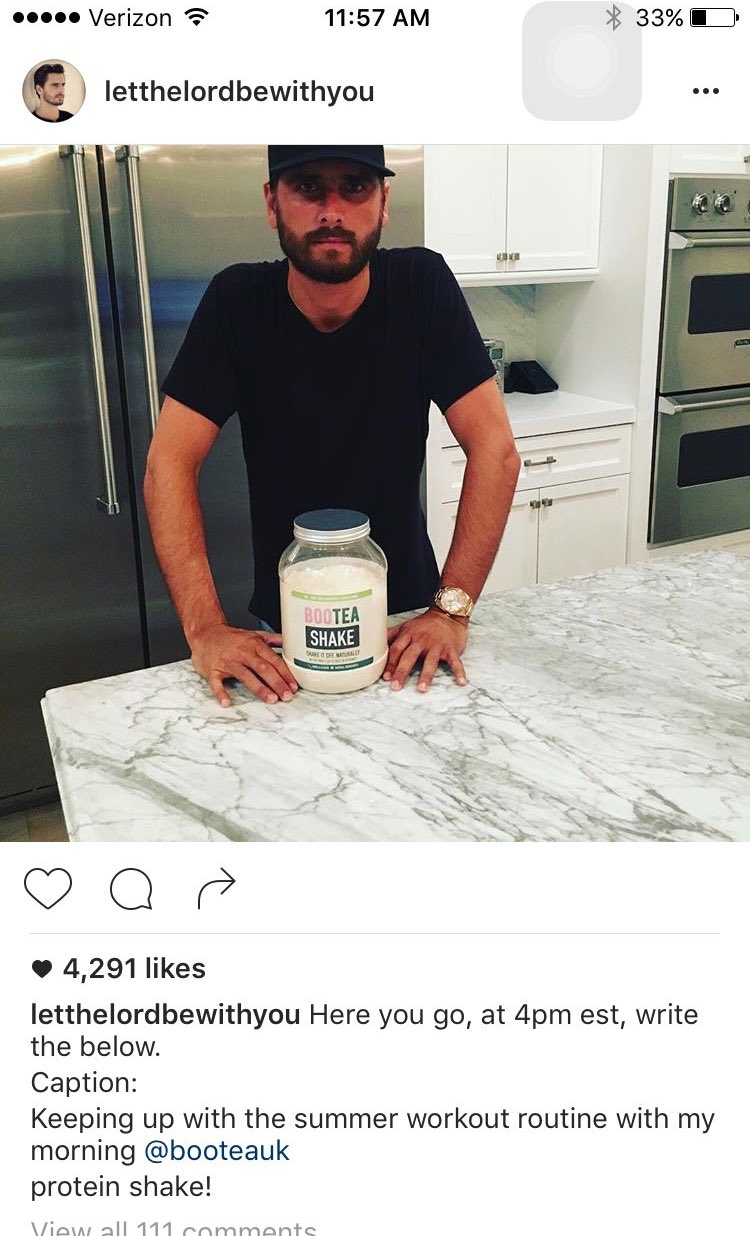
This guy probably made tens of thousands of dollars from a botched copy and paste.
It was widely publicized a few years ago when Kendall Jenner got $250K for a single post promoting the Fyre Festival (if you haven't heard of the Fyre Festival, you should look it up, just don't buy a ticket). But many influencers are more crafty (...and careful), and prefer to advertise without people even knowing that they're advertising.
Aren't there laws around advertising though? And wouldn't you know if they were selling and not just making a genuine post about their lives?
Yes... and no.
For her part, Jenner got busted and had to pay $90K to settle a lawsuit (which she paid using money found in her couch cushions).
But most influencers fly under the radar, sell discreetly, and disclose nothing. No one's the wiser. Statistics show only about 1 in 4 of influencers actually disclose that they're advertising, in the way that the law and the Federal Trade Commission require.
According to a study by affiliate network Awin that covered the top 100 posts for each of the approved disclosure hashtags, 76% of posts attempted to hide the #ad disclosure from view. And only 13% mentioned a paid relationship with a brand.
Who would do that unless they didn't want you to know that what you're looking at is actually just another advertisement?
Not every influencer has 1,000,000 followers, but they still have what advertisers want: you
Jenner bankrolls on her social media presence — typically earning about $500K per post. But you don't have to be a celebrity, famous athlete, or model to earn good to great money by doing the same. ”Micro-influencers”, which are those with 10,000-50,000 followers, can earn between $40,000 and $100,000 per year just from social media. Even the smallest “nano-influencers” — those with 1,000-10,000 followers, can earn money and free stuff by promoting and advertising to their followers.
To make the whole thing extra shady, these micro and nano influencers almost always seem like normal people. They could be your neighbors, local sports figures, or people you knew in high school. They probably seem completely genuine and authentic. And maybe they are, in some ways. But if they're selling and promoting, then they are, by definition, compromised and their interests conflict with yours. How can they ever be genuine when their mortgage gets paid by you buying from their partners?
This means that what you're seeing on Instagram may not be that local celebrity chef authentically “trying out a new kitchen mixer” and sharing it on social media, it's them selling kitchen mixers to you, and being paid to do so.
Advertisers especially love micro and nano influencers, and pay them handsomely to promote and push products. It's a great setup for both because the followers engage with them and trust them.
If you're one of those followers, it's time to rethink whether they deserve it.
4: High-tech, effective ads
If radio advertising was a horse and buggy, social media advertising would be a Tesla
Ads today aren't like the ads your grandparents got on the radio. They're not a jingle and a handshake understanding that if you didn't buy what they were selling... well, that was cool and you'd both move on.
Today, advertisements are stalkers.
They know where you go. They know where you've been. They don't take “no” for an answer. They even follow you around the internet, repeatedly asking “are you sure? Are you sure?”. It's enough to make even timeshare salesmen and trinket sellers on Dominican beaches blush. At least those guys don't follow you home, yelling in your ear.
In any other situation, this would horrify people.
But for some reason, with ads it's tolerated, and has become socially acceptable. People even rationalize it as “they're only selling what I want”, without acknowledging that the advertiser only found out about what you wanted by spying on you and using the personal data that you didn't even know they had.
There are a few novel ways that ads work today that make you more likely to spend money.
- Data collecting and mining for effective advertising
If there's something that you're searching for, talking about, sharing, or “liking” on social media, it isn't just being noticed by your friends and followers. It's being closely watched by the social media platforms. Each minute, over 130,000 photos are uploaded to Facebook, over half a million comments are made, and almost 300,000 statuses are updated. Every one of them is tracked, tagged, and cataloged.
Facebook and the gang know what you look like. If you post updates, they know what you're doing. They know what you like and they know who your friends are. And they are experts are collecting this seemingly unrelated data, and baking it into something that they can use.
Research by Cambridge University shows that you can be accurately categorized in a number of ways just from your “likes”. That includes satisfaction with life, intelligence, emotional stability, religion, alcohol use and drug use, relationship status, age, gender, race, and political views.
Ultimately, all of this information and analysis is used to create a “profile” of you. A profile that includes notable detail about your life, and by extension, how you behave. And what's that profile for? To categorize you and package you up for consumption. Remember, you're the product.
For advertisers, that means they can target those who are most likely to buy from them. They can avoid those who their marketing research shows are unlikely to buy. For you, it means that the ads you're seeing on social media are often tailored to your personality. You're more likely to buy, and you're more likely to spend money.
- Location
People don't just use social media at home. About 80% of social media time is accessed via smartphone and about 50% of the time spent on smartphones is spent using social media. That means that you could be anywhere when you're scrolling or (more to the point) checking out new clothes or gadgets.
You might think that where you go on your weekend errands is mundane, but to advertisers, that information is gold. Why waste advertising budget on targeting people who are anywhere, when you can concentrate on those who are near your store?
This is called “geofencing”. It sounds sophisticated, but all it means is showing you ads when you're at or near the retailer. This can get even more focused using “beacons” (a cousin of geofencing), which are small devices that send out a Bluetooth signal to your phone to trigger an ad based on where you're at. So next time you're near a Starbucks and you get an ad in your Facebook feed, or you get a coupon blasted to your phone when browsing in your favorite clothes store after liking something you saw on Instagram, now you know it's not a coincidence. It's another carefully constructed scam designed to separate you from your money.
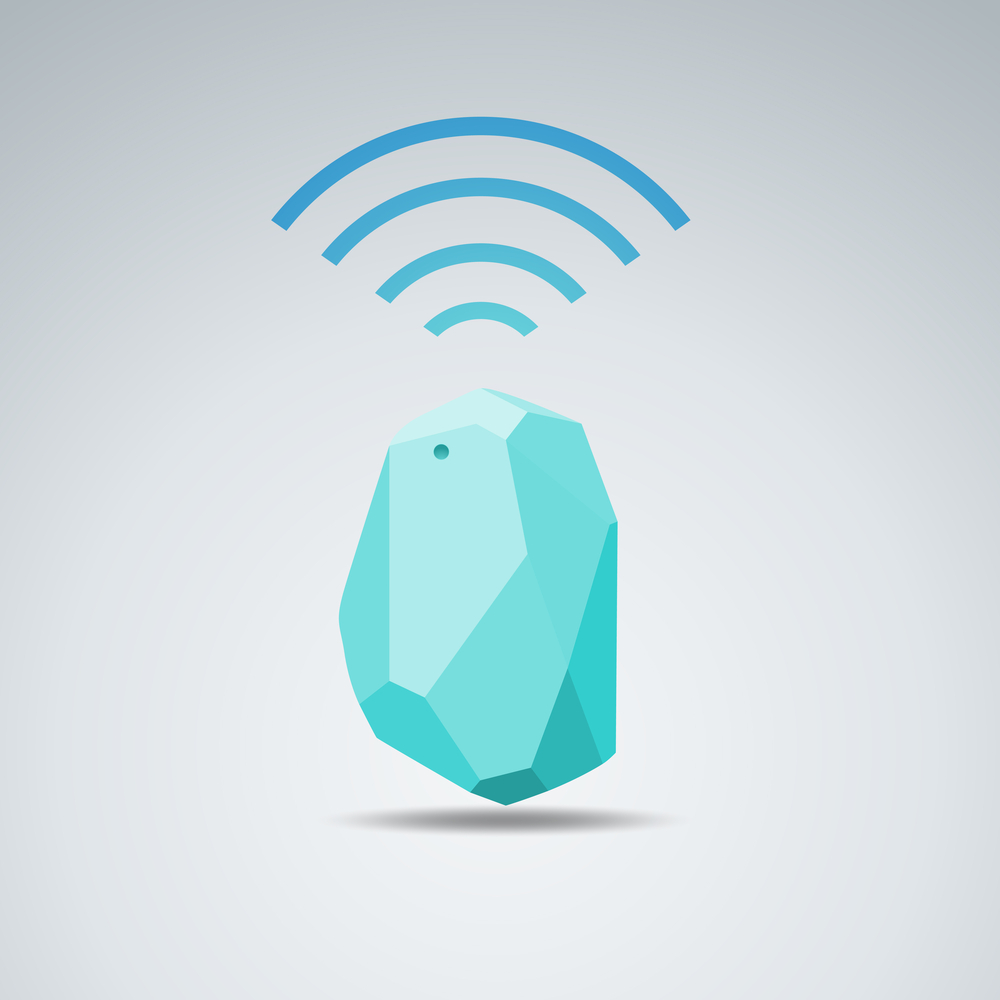
A beacon, sending a signal to your phone to advertise to you. Yes, this is real.
All of this is great for advertisers (and social media, by extension) but what about you, the “target”?
Well, 91% of male survey respondents aged 18-34, and 76% of women admitted that they were influenced by personalized in-store advertising by beacons (those triggers for smartphone ads). And 64% of people say that they experienced some buyer's remorse when buying something on sale. Deep down, you know that impulsive consumer behavior isn't positive. Being manipulated doesn't help.
- Ad retargeting
Have you ever looked at something on the web, and then noticed that you keep seeing ads for the exact thing that you looked at, everywhere you go?
Again, this isn't a coincidence. It's a carefully designed marketing strategy. This one is called “ad retargeting”. It works like this. You go visit a website, and view a specific item they have for sale. To demonstrate, let's just say it's a pair of shoes. The website selling the shoes installs a small piece of code, called a “cookie” onto your browser.
These are harmless on their own, but they're snitches.
Because later, when you log onto Facebook or Instagram, those sites or apps recognize this cookie, and serve you ads accordingly. Suddenly the shoes you looked at earlier are in front of you again. When you log in the next day, it's the same story. Hello shoes again.
About 97% of website visitors leave without buying something, and never return (probably because the visitor didn't need what was being sold to begin with). But if that visitor is later served ads based on what they looked at or expressed interest in, they are 70% more likely to buy. If you see the same ad 5 or 6 times, you're twice as likely to buy. And if the advertiser follows Facebook's guidance and continuously targets visitors inside of 15-30 days, you're even more likely to recall and respond to the ad.
Technically, this marketing scheme isn't strictly limited to social media. But they are a huge player, and given the amount of time spent on these sites and apps, it's one of the largest contributors to ads being served through retargeting.
What you can do about it
What can you do against this onslaught on your mind and money? It's up to you to protect yourself. Here are a few ways that you can fight back.
Don't believe the hype
Think about how ridiculous social media is. Nothing that you see there actually matters.
This may not be 100% true, but it's easily 99.9% true, and definitely true enough to use as a rule of thumb when you're making money decisions. Everything that you see is fake to some degree, and you AREN'T missing anything.
On the other end of each and every airbrushed and carefully curated picture or video you see is another human being, probably uploading photos while driving and swerving into your lane while you're trying to get to work. They are nothing special. They're only other people, with their own problems, and their own issues. Some of them are undoubtably worse than yours.
Don't do anything purely for social media
Even if you're the one doing the posting, think about how you view content on social media...
Scroll
Scroll
Scroll
Turns out, that's what other people do for yours, too. They glance at it passively and breeze past it.
Take social media for what it is, and don't spend any money or do anything that takes even a little bit of your time and effort solely to try and impress other users. You're better off spending your efforts on the things and people that truly matter to you.
And be honest with yourself. If you couldn't put it on social media, would you be doing/buying it?
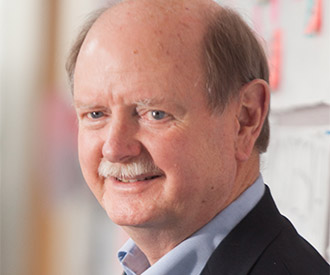
You probably wouldn't worry about what people think of you if you could know how seldom they do...
- Olin Miller
Understand that both social media and influencers want to sell to you, and act accordingly
Social media makes money through advertising. That's what their business model is. Businesses aren't charities, and if they aren't selling a product (you're getting it for “free”), then you can be certain that you are the product. That isn't good or bad, it just is. Understand what social media is and what they want you to do, so you aren't being suckered.
As a rule of thumb, if someone has 1,000+ followers, there's a significant chance that what you're seeing from them may be an advertisement. Keep this in mind when you're reading, looking, and watching videos from people with large followings. You should especially look out for “reviews” and recommendations. Unless you exercise discretion on what you're seeing, you wouldn't know that they're not sharing their life ... they're promoting a product. Treat it like you would any other advertisement.
There are a couple strategies to counteract and fight against being sold.
One is to vow to never buy anything via social media unless you proactively sought it out. If you want to use social media to see what your friends say about a product, that's fine. But avoid impulse buys of things that you didn't even know existed before you logged on. Another option is to create a personal “cooling off period”. Instead of buying what you're looking at, simply write it down so you don't forget about it. Wait 7 days, and if you still want it then, go ahead and get it.
This neuters many marketing tactics and also works outside of social media. Try it.
Extreme measures
Sometimes the mental parts aren't enough and you have to break out the big guns. If you're really struggling, here are some concrete things you can do (easiest to hardest):
Unfollow personalities and brands who tempt you
Frequently clear your browser history to break up the bread crumb trail for the algorithms, or better yet, browse only in an incognito/private window to muck up their tracking
Unlink your credit cards from your phone or browser to make yourself work harder to make purchases
Take a social media vacation
Start tracking your social media use with an app or on paper
Quit social media altogether — you get nothing out of it, and it has no unique benefits, or benefits that you couldn't get somewhere else proactively. It makes you a passive consumer. It wastes your time. You don't need it.
If you feel small and alone against a large army of sophisticated and aggressive predators, that's fine. Because it's largely true. But you've got a trump card that they can never match. YOU make the decisions for your money and your life, not them. And now you're armed with the knowledge you need to be informed and thoughtful about it. Time to put it into practice.
Video coming soon...
Share this post
There are no comments yet.

Pete Zimmerman
I've worked in financial services for more than a decade, and know where all the bodies are buried (and where the motivations are). I'm a Certified Financial Planner® and a licensed real estate broker, and love using what I've learned to simplify financial concepts and bring them to life in the real world, for working-class people like you.
Interested in more money ideas and solutions for your life?
Join Cashbasic's mailing list today and get exclusive content and offers direct to your inbox.
Social Connections
Special Thanks
Get Cashbasic's very best content (and exclusive offers) direct to your inbox.
No spam, ever. And we never share or sell your information.
